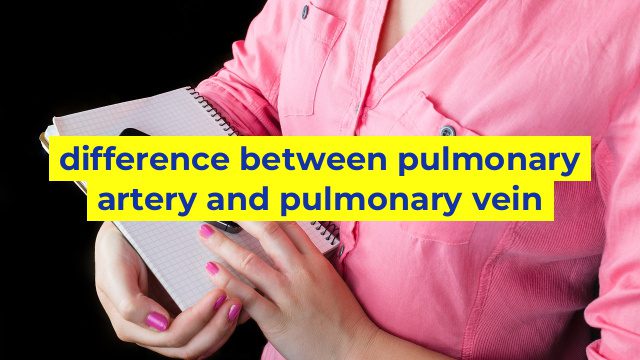Difference Between Pulmonary Artery and Pulmonary Vein
The cardiovascular system of our body comprises of four major vessels, including the pulmonary artery and pulmonary vein. As the names suggest, both these vessels are linked to the lungs, but they perform different functions. In this article, we will discuss the key differences between the pulmonary artery and pulmonary vein.
Pulmonary Artery
The pulmonary artery is an essential vessel that carries deoxygenated blood away from the heart and towards the lungs. This artery is responsible for taking the blood from the right ventricle of the heart to the lungs, where the blood is oxygenated. The pulmonary artery branches out into the lungs, and the tiny blood vessels within the lungs are called capillaries. When blood flows through the capillaries, it gets oxygenated, and carbon dioxide is removed from it.
Pulmonary Vein
The pulmonary vein, on the other hand, is responsible for carrying oxygenated blood from the lungs back to the heart. It plays an essential role in transporting fresh blood from the lungs to the left atrium of the heart, where it is pumped into the body to supply oxygen and nutrients to the cells. The pulmonary vein is made up of four separate veins that merge together and form a single vein that enters the left atrium.
Differences Between Pulmonary Artery and Pulmonary Vein
Now, let’s discuss the key differences between the pulmonary artery and pulmonary vein:
- The pulmonary artery carries deoxygenated blood from the heart to the lungs, while the pulmonary vein carries oxygenated blood from the lungs back to the heart.
- Pulmonary artery is larger in diameter than pulmonary vein.
- The wall of the pulmonary artery is thicker than the pulmonary vein due to the higher pressure it must withstand.
- The pulmonary vein contains more oxygen and less carbon dioxide and the opposite is true for the pulmonary artery.
Conclusion
In conclusion, the pulmonary artery and pulmonary vein play crucial roles in the functioning of the cardiovascular system. While the pulmonary artery carries deoxygenated blood from the heart to the lungs, the pulmonary vein carries oxygenated blood from the lungs back to the heart. Understanding the differences between these two vessels is essential to understand the overall structure and functioning of the cardiovascular system.
Table difference between pulmonary artery and pulmonary vein
| Feature | Pulmonary Artery | Pulmonary Vein |
|---|---|---|
| Function | Carries deoxygenated blood from the heart to the lungs for oxygenation | Carries oxygenated blood from the lungs to the heart to be distributed to the rest of the body |
| Origination | Originates from the right ventricle of the heart | Originates from the lungs |
| Destination | Delivers deoxygenated blood to the lungs for oxygenation | Delivers oxygenated blood to the left atrium of the heart |
| Blood Flow | Single direction (heart to lungs) | Single direction (lungs to heart) |
| Diameter | Larger in diameter | Smaller in diameter |

